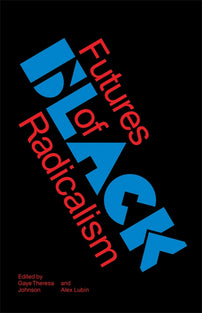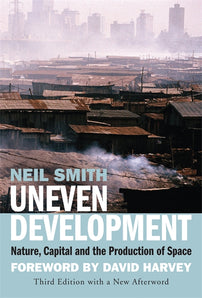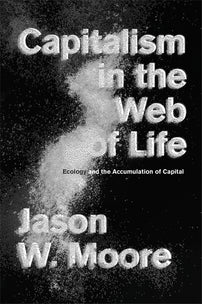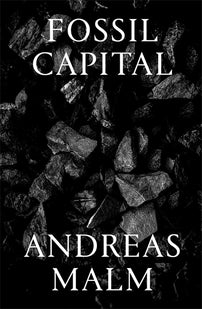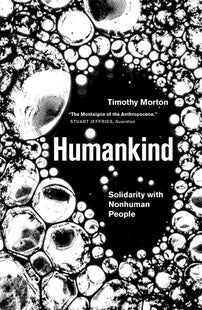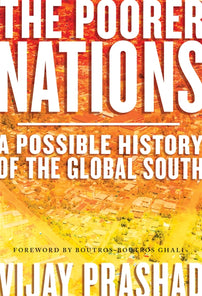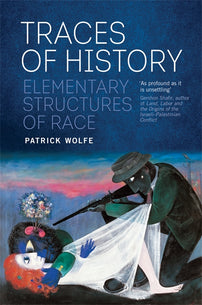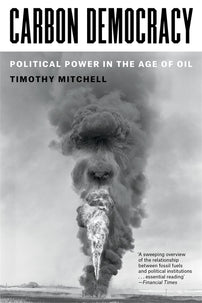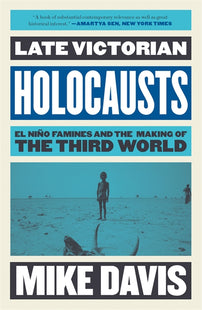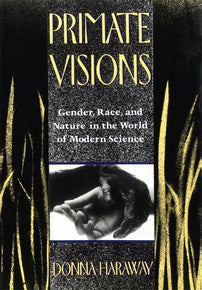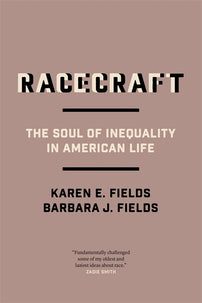Racial Capitalocene
Is the Anthropocene racial?
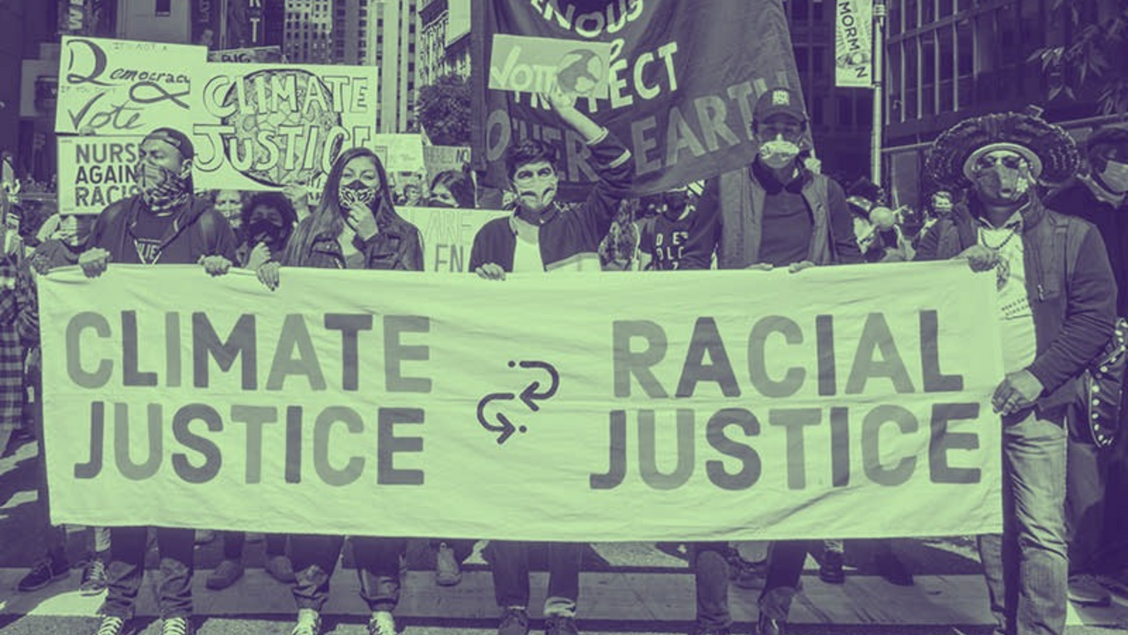
Futures of Black Radicalism, edited by Gaye Theresa Johnson and Alex Lubin, brings together 17 essays on the development of the black radical tradition, all informed by both the groundbreaking work of Cedric J. Robinson and the contemporary flourishing of black political movements.
Included in the collection is the essay by Françoise Vergès reprinted below. Vergès examines how most theories of the anthropocene have failed to reckon with the ways in which racism and imperialism structure the uneven distribution of climate catastrophe.
In the debates on the “Anthropocene,” global warming, and climate change, voices of the South and of minorities — the prime victims of these phenomena’s consequences — have developed an analysis that brings together race, capitalism, imperialism, and gender. This analysis rests on past struggles, such as the organization of farmworkers led by Cesar Chavez in California in the early 1960s for workplace rights, including protection from toxic pesticides, and of African American students in 1967 to oppose a city dump and in 1979 to oppose a landfill in Houston. Environmental racism became a site of struggle. The publication in 1987 of Toxic Waste and Race in the United States, a report by the Commission for Racial Justice of the United Church of Christ, was a turning point. 1 It showed that race was the single most important factor in determining where toxic waste facilities were sited in the United States and that the siting of these facilities in communities of color was the intentional result of local, state, and federal land-use policies. In the 1980s, the Reagan administration’s practice of cutting the budgets of federal environmental agencies had aggravated racist decisions. The report demonstrated that “three out of every five Black and Hispanic Americans lived in communities with uncontrolled toxic waste sites.” 2 Twenty years later, the United Church of Christ published another report confirming that “people of color make up the majority of those living in host neighborhoods within 3 km of the nation’s hazardous waste facilities. Racial and ethnic disparities are prevalent throughout the country.” 3
Between the two reports a global movement for environmental justice had emerged. In October 1991, the Delegates to the First National People of Color Environmental Leadership Summit drafted and adopted the “Principles of Environmental Justice,” which became a defining document for the growing grassroots movement for environmental justice. The preamble read:
WE, THE PEOPLE OF COLOR, gathered together at this multinational People of Color Environmental Leadership Summit, to begin to build a national and international movement of all peoples of color to fight the destruction and taking of our lands and communities, do hereby re-establish our spiritual interdependence to the sacredness of our Mother Earth; to respect and celebrate each of our cultures, languages and beliefs about the natural world and our roles in healing ourselves; to ensure environmental justice; to promote economic alternatives which would contribute to the development of environmentally safe livelihoods; and, to secure our political, economic and cultural liberation that has been denied for over 500 years of colonization and oppression, resulting in the poisoning of our communities and land and the genocide of our peoples. 4
The authors of the 2007 report warned that “for many industries, it is a ‘race to the bottom,’ where land, labor and lives are cheap.” 5 Similar studies in India, South Asia, South America, Africa, and Europe demonstrated a global pattern of environmental racism and the ways in which states and multinationals have been avoiding environmental justice.
In this chapter, I try to answer the following question: Though minorities and peoples of the South have shown that they are the victims of racialized environmental politics — toxic waste, polluted water and rivers, pesticides, polluted food — have studies on the emergence of the “Anthropocene” addressed the role of race in its making? In other words, is the Anthropocene racial? Scholars have studied race as a central element of destructive environmental policies, but what connection can be made between the Western conception of nature as “cheap” and the global organization of a “cheap,” racialized, disposable workforce, given the conception of nature as constant capital and the fact that “the organizers of the capitalist world system appropriated Black labor power as constant capital”? 6 What methodology is needed to write a history of the environment that includes slavery, colonialism, imperialism and racial capitalism, from the standpoint of those who were made into “cheap” objects of commerce, their bodies as objects renewable through wars, capture, and enslavement, fabricated as disposable people, whose lives do not matter?
What does this have to do with Cedric Robinson? In Black Marxism, Robinson writes that “for the realization of theory we require new history.” He adds, “Black radical theory was not made by choice but dictated by historical inheritance.” 7 In the spirit of Robinson’s advice, I will try in this chapter to suggest ways of writing a history of environment that takes into account the history of racial capitalism. My interest in the history of racialized environmental politics is partly biographical: I come from Réunion Island in the Indian Ocean, which became a French colony in the seventeenth century and is today a French department. Growing up in a communist, anticolonial, and feminist family, I learned early that the environment had been shaped by slavery and colonialism — a reading of space that gave meaning to where cities were built, where poor people lived, and how the large sugarcane fields, rivers, mountains, volcanos, and beaches had been inscribed in the colonial and postcolonial economy. I studied the combined work of scientists (first botanists, then biologists, oceanographers, and volcanologists), engineers, soldiers, and business executives (whether slave traders, slave owners, bankers, or multinational CEOs), which fabricated “nature” as excess that needed to be tamed and disciplined and, through the tourism industry, enjoyed. I observed how the Cold War and studied the nature of the “green revolution” continued to transform nature in the Indian Ocean and the alliance between the military, the engineering company, the multinational, and the scientist. More recently, understanding what is at stake in the negotiations about “climate change” means considering the place of these stakeholders in the context of a global counterrevolution — the erosion of rights, the politics of nonraciality beneath which, as David Theo Goldberg has argued, lurk more sinister shadows of the racial everyday and persistent institutional and structural racisms — and racial capitalism. Global warming and its consequences for the peoples of the South is a political question and must be understood outside of the limits of “climate change” and in the context of the inequalities produced by racial capital.
Anthropocene or Racial Capitalocene?
The term “Anthropocene” to describe the “human dominance of biological, chemical and geological processes on Earth” was first introduced in 2000 in an article jointly written by Paul Crutzen and Eugene Stoermer. They dated its emergence to the latter part of the eighteenth century, admitting that
alternative proposals can be made (some may even want to include the entire Holocene). However, we choose this date because, during the past two centuries, the global effects of human activities have become clearly noticeable. This is the period when data retrieved from glacial ice cores show the beginning of a growth in the atmospheric concentrations of several ‘‘greenhouse gases,’’ in particular CO2 and CH4. Such a starting date also coincides with James Watt’s invention of the steam engine in 1784. 8
When and why the Anthropocene had occurred, its dangers, and what could stop them were widely debated in scientific journals and conferences. The narrative centered on the threat to human beings as an undifferentiated whole and was summarized thus: humanity would not survive if it did not slow down the emission of CO2. Films and advertisements began to highlight the dangers of climate change, accentuating the loss of animal species and the idea of Earth as a common good. These media did not, however, take into account the asymmetry of power and instead marginalized what had been demonstrated in the 1980s: the role of racialized policies of public health and toxic waste disposal, weapons and pollution, land grabs and deforestation, the importance of the Cold War with its alliance between the chemical industry and the military, laws of commerce and monopolies. It was remarkable that these studies did not seek to locate points of intersection with emerging studies on imperialism and environment. 9 When Dipesh Chakrabarty wrote “The Climate of History: Four Theses” in 2009, the hope was that a dialogue was finally starting between scientists and postcolonial thinkers. 10 By focusing on the immediacy of climate change as a crisis, Chakrabarty framed the Anthropocene as a current transformation. This presentism ignored a deeper history and created the illusion of an organic and undifferentiated universal humanity. In his 2012 essay “Postcolonial Studies and the Challenge of Climate Change,” Chakrabarty referred again to the abstract figure of “the human in the age of the Anthropocene,” but, moving away from his 2009 conclusion somewhat, stated: “There is no corresponding ‘humanity’ that in its oneness can act as a political agent. A place thus remains for struggles around questions on intrahuman justice regarding the uneven impacts of climate change.” 11 In answering his critics especially about “the rich always having lifeboats and therefore being able to buy their way out of all calamities including a Great Extinction,” he asked, “Would not their survival also constitute a survival of the species (even if the survivors quickly differentiated themselves into, as seems to be the human wont, dominant and subordinate groups)?” 12 Chakrabarty defends a notion of the Anthropocene that, according to Aaron Vansintjan, infers a “blanket humanity, a blanket history, a blanket geological record” 13 which relies on “apolitical and colonialist assumptions” and “highlights the danger of using one framework (geology and climatology) to make universal claims about the world — it helps make only one world possible.” 14
But the Anthropocene is a catchy term that makes for an easy story.
Easy, because it does not challenge the naturalized inequalities, alienation, and violence inscribed in modernity’s strategic relations of power and production. It is an easy story to tell because it does not ask us to think about these relations at all. 15
The notion “sweeps up within it the diverse, dynamic, and even contradictory discourse of peoples throughout the globe contending with catastrophic environmental change” and maintains the nature/society division dear to Western thought, masking the fact that relations between humans are themselves produced by nature. 16 The notion of the Anthropocene is “de-historicizing, universalizing, eternalizing, naturalizing a mode of production specific to a certain time and place,” a strategy of ideological legitimation that blocks off any prospect of change. 17 Student of anthropology Elizabeth Reddy has coined the expression “charismatic mega-category” to describe the temporality and spatiality produced by the notion of the Anthropocene. 18 Sociologist Jason Moore has suggested the notion of a Capitalocene 19 which brings back capitalism “as a world-ecology, joining the accumulation of capital, the pursuit of power, and the co-production of nature in dialectical unity.” 20 As Moore puts it, scholarship that posits
the exploitation of nature as an external relation to the exploitation of labor power does two things. First, it confuses matters, because nature and labor are not comparable entities. Nature is the field within which human activity unfolds, and is also the object, and precondition of, human activity. Second, it confuses matters yet further by establishing an arbitrary discontinuity between human environment-making — the exploitation of nature — and environment-making by other forms of life. 21
Moore dates the beginning of the Capitalocene to the sixteenth century, which also witnessed the “discovery of the New World” into which people were brought through the force of “blood and fire,” the slave trade, the division of colonies among European powers, and the organization on a global scale of a mobile, racialized, gendered, and bonded workforce. Slavery and colonialism had a deep impact on the world-ecology. 22
To the historian Joachim Radkau, “the chief problem of colonialism seems to have been not so much its immediate ecological consequences as its long-term impact, the full extent of which became apparent only centuries later, in the era of modern technology, and many times only after the colonial states had acquired their independence.” 23 We must, in our narrative of the racial Capitalocene, integrate this long memory of colonialism’s impact and the fact that destruction in the colonial era becomes visible in the postcolonial era. In other words, we must add to the United Church of Christ’s 1987 study of racialized policies of the environment in the twentieth century a history of racial Capitalocene, with an analysis of capital, imperialism, gender, class, and race and a conception of nature and of being human that opposes the Western approach. In the 1991 “Principles of Environmental Justice,” the first principle stated that “Environmental Justice affirms the sacredness of Mother Earth, ecological unity and the interdependence of all species, and the right to be free from ecological destruction.” The principle posits a new understanding of what it is to be human and challenges the international dialogue on climate change that focused on a strategy of adaptation. Adaptation through technology or the development of green capitalism has indeed been presented as a good strategy. Yet it does not thoroughly address the long history and memory of environmental destruction about which Radkau has written, nor the asymmetry of power.
In the reconfiguration of the world that followed the colonization of the Americas and the Caribbean, nature was transformed into a cheap resource, as endlessly renewable as the bonded workforce. It is human praxis as labor and the global use of a color line in the division of labor that must be studied, and not a “human” death drive. When Andreas Malm argues that “there is also a different kind of violence, not rapid but slow motion, not instantaneous but incremental, not body-to-body but playing out over vast stretches of time through the medium of ecosystems,” he raises the question of the narratives that would bring to light this kind of violence. Indeed, if we find and read “stories and essays on the slow violence of the Bhopal disaster, oil exploitation in the Arabian Gulf and the Niger Delta, mega-dams in Indian, depleted uranium in Iraq” — to which we can add Katrina in New Orleans, the moving tide of toxic iron-ore residue in Brazil, polluting the water supply of hundreds of thousands of residents as it makes its way to the ocean, the consequences of nuclear tests in French Polynesia, the polluted water in Flint, Michigan, and the negative impact of agro-business — there are none “on climate change as such,” as if “the capacity to imagine violence seems to have reached its limits.” 24 We have to renew the ways that violence is narrated.
Apocalyptic/Optimistic Views of Climate Change and Environmental History
Two views about climate change and the environment have been dominating the media and politics shaping the public debate: apocalyptic (humans are responsible for ecological destruction) and optimistic (scientists and engineers will find solutions). In 1991, Clive Ponting’s book A Green History of the World offered a wide view of human and ecological history that covered the globe and centuries. Though Ponting discussed slavery, colonialism, and the creation of the Third World, “Man” was his main culprit. But it was his narrative of the ecological suicide of Easter Islanders that became the exemplary apocalyptic narrative. In his opening paragraph, Ponting wrote:
Easter Island is one of the most remote, inhabited places on earth. Only some 150 square miles in area, it lies in the Pacific Ocean, 2,000 miles off the west coast of South America . . . At its peak the population was only about 7,000. Yet, despite its superficial insignificance, the history of Easter Island is a grim warning to the world. 25
Ponting’s analysis blamed the disappearance of Eastern Islanders on a human predisposition for destruction. His book was an instant success, offering a paradigm for the whole environmental history of the world that both frightened and pacified: if there was nothing to do, there was nothing to do. The book inspired, and continues to inspire, movies and novels. A whole genre of popular cinema has blossomed that offers a narrative of human hubris in which a white American male saves first “his” family and then “his” community. Individual mad scientists or cynical politicians are the villains; nothing is said of an economic system that privileges profit and fabricates racialized, disposable beings. The success of Ponting’s book shows why the apocalyptic narrative is an ideological strategy that blames out-of-control forces rather than structures of power. But Easter Islanders did not commit suicide; they were the victims of systematic murder committed by Peruvian slave traders in the nineteenth century. The apocalyptic view rests on a pessimistic view of human nature. The optimistic view, on the other hand, is deeply steeped in the tradition of belief in progress. Ferdinand Braudel, whose work has been vital to historians of the environment, embodies that tradition. To him, climate is a longterm, mostly stable element which changes more slowly than historical time (though Braudel sometimes portrays nature — the sea, the mountains, rice, maize — as the main actor of history). Yet, as Eyal Weizman has written,
the climate can no longer be considered a constant . . . The current acceleration of climate change is not only an unintentional consequence of industrialization. The climate has always been a project for colonial powers, which have continually acted to engineer it. 26
Apocalyptic and optimistic approaches have inspired the current rhetoric of a “crisis” produced by human nature or by an error in progress, evident in three recent moments in politics of the environment. The first moment is the emergence of a Western-led transnational network of conservation work which appeared in the years before World War I. The second is the Western-led boom of environmentalism that appeared around 1970 and developed rapidly in response to decolonization, the first oil crisis, the alliance between the chemical industry and the army (pesticides for war and the green revolution), the culmination of international programs on birth control in the Third World, the War in Vietnam, the proxy wars in Africa, revolutionary social movements, the dictatorships in South America, the interventions in the Middle East. 27 Indeed, starting in the early 1970s, European states as well as the United States started to issue regulations about clean air, clean water, and the protection of nature. In 1972, The Limits to Growth by the Club of Rome became an international best seller; that year in Stockholm, representatives from more than 100 countries met for the first United Nations Conference on the Human Environment and the United Nations Environment Programme (UNEP) was created. The third moment is the upswing of environmental issues all over the globe at the end of the Cold War, culminating in the Earth Summit in Rio de Janeiro in 1992. In December 2015, not long aft er the Paris attacks, the COP 21 opened. The rhetoric on the relationship between political opposition to climate change and world security, and the “war on terror,” has opened a new chapter in the development of the racial Capitalocene.
To unpack the different levels of racialized environment we need to go back the long sixteenth century, the era of Western “discoveries,” of the first colonial empires, of genocides, of the slave trade and slavery, the modern world mobilized the work of commodified human beings and uncommodified extra-human nature in order to advance labor productivity within commodity production. Racialized chattel were the capital that made capitalism. Africa was forced to share its social product — human beings — with the Atlantic slave system. But the slave trade consisted of not only the organized deportation of millions of Africans to continents and islands, but also a massive transfer of plants, animals, diseases, soil, techniques, and manufactured goods from Europe. Capitalism relied for growth on an endless access to nature as excess, as a “bounty of extra-human biological systems and geological distribution: plants, silver, gold, iron, coal.’’ 28
Radical Agenda
A history of the racialized Capitalocene à la Cedric Robinson will help us understand that climate change is not about human hubris, but the result of the long history of colonialism and racial capitalism and its Promethean thinking — the idea that “Man” can invent a mechanical, technical solution to any problem. To develop a theory from a renewed history of the racial Capitalocene is to study the matrix constructed by the army/science/engineers/business/state alliance. On January 8, 2016, a court in Oregon fined the Biotech firm ArborGen $53.5 million in compensation and punitive damages for using “trickery and deceit” to defraud workers. ArborGen is a US-based company, a leader in research and development for genetically engineered trees. It presents itself as a “leading global provider of conventional and next generation plantation trees.” 29 The company develops mostly eucalyptus, which is the second-most-popular tree for the paper industry (pine is the first). On its website appear the following questions and their answers: “What Makes a Profitable Forest? Advanced Technology, Incomparable Value”; “What Makes a Valuable Tree? Superior Growth, Maximum Value”; “What Makes a Superior Seed? Exceptional Breeding, Outstanding Results.” It is the vocabulary of profit for profit. ArborGen has a rival: the Israeli biotech company Futuragene, which has developed a unique technology that accelerates tree growth, again mostly eucalyptus. It is now a branch of the Brazilian plantation group Suzano, which grows 500,000 hectares of eucalyptus trees a year and has partners in China, Thailand, and South Africa. ArborGen and Suzano compete in an industry (forestry and paper) which generates $400 billion annually. The eucalyptus is known for being invasive and contributing to the depletion of water, desertification of soils, and loss of biodiversity. Once they are engineered, these effects are multiplied. Further, the paper industry always hides the waste it produces. Yet, waste embodies, more than ever before, the new era of the Capitalocene. Capitalist production is waste production. According to a 2000 study carried out by five major European and US research centers, one-half to three-quarters of annual resource inputs to industrial economies are returned to the environment within a year as waste. It must be said, however, that there is a huge gap between the amount of waste produced by multinationals and countries of the North and the amount of waste produced by populations of the South. 30
Green capitalism and the biotech industry hold the optimistic discourse, offering seductive solutions: a green and sustainable future created by engineers and scientists, with the help of drones, satellites, and the new international laws of property and trade. Philosopher Isabelle Stengers has argued that we are witnessing an authoritarian management of societies based on Margaret Thatcher’s “There Is No Alternative.” Stengers argues for a “skepticism of the probable” in order to take a stand with the “possible” and commit to the multiple and always precarious attempts which bet on the possibility of a world which does not answer the probabilities offered by green capitalism. Building counterpowers means exposing the dangers of bioengineering to human health, biodiversity, and the lives and well-being of minorities, indigenous communities, and poor peasants, the majority of whom are women. It also means developing a radical curriculum based on a decolonization of knowledge production and institutions and a de-nationalization of knowledge. Knowledge production must take place with an awareness of diverse living realities and multiple publics without imposing the distance, disregard, or disdain of privilege. World citizenship and humanism must be brought in as decolonializing alternatives. A curriculum of radical pedagogy for the politics of the possible will challenges all forms of dehumanized work in favor of shared, life-affirmative labor practices, resisting the economy of speed for efficiency and acknowledging that time is needed to nourish knowledge. The politics of the possible also rest on the imagination — on the freedom to dream other pasts and imagine other futures than those suggested by the racial Capitalocene. Afrofuturism, for example, offers a way of looking at possible futures or alternate realities through a Black cultural lens, blending the future, the past, and the present. “Each generation must out of relative obscurity discover its mission, fulfill it, or betray it,” Frantz Fanon wrote in 1961. We are at a critical juncture, a historical moment that sends us into our inheritances to find sources and references for the struggle ahead.
Notes
1. United Church of Christ Commission for Racial Justice, Toxic Wastes and Race in the United States: A National Report on the Racial and Socio-Economic Characteristics of Communities with Hazardous Waste Sites (New York: 1987).
2. Ibid, xiv.
3. United Church of Christ Justice and Witness Ministries, Toxic Waste and Race at Twenty, 1987–2007: Grassroots Struggles to Dismantle Environmental Racism in the United States (March 2007), 11.
4. First People of Color Environmental Leadership Summit, “Principles of Economic Justice” (1991), available at ejnet.org.
5. United Church of Christ, Toxic Waste and Race at Twenty, 14.
6. Cedric J. Robinson, Black Marxism: The Making of the Black Radical Tradition (Chapel Hill: University of Carolina Press, 1983), 309. Emphasis in original.
7. Robinson, Black Marxism, 307.
8. Paul J. Crutzen and Eugene F. Stoermer, “The ‘Anthropocene’,” International Geosphere-Biosphere Programme 41 (2000): 17–18.
9. See William Beinart and Lotte Hughes, eds., Environment and Empire (Oxford: Oxford University Press, 2007); Alfred W. Crosby, Ecological Imperialism: The Biological Expansion of Europe, 900–1900 (New York: Cambridge University Press, 2004); Daniel R. Headrick, Power over Peoples: Technology, Environments, and Western Imperialism, 1400 to the Present (Princeton: Princeton University Press, 2012).
10. Dipesh Chakrabarty, “The Climate of History: Four Theses,” Critical Inquiry 35, no. 2 (2009): 197–222.
11. Dipesh Chakrabarty, “Postcolonial Studies and the Challenge of Climate Change,” in Pramod K. Nayar, ed., Postcolonial Studies: An Anthology (Wiley-Blackwell, 2015), 144–57, 145, and 154.
12. Dipesh Chakrabarty, “Whose Anthropocene? A Response,” RCC Perpsectives: Transformations in Environment and Society, no. 2 (2016), 112.
13. Aaron Vansintjan, “Going Beyond the ‘Ecological Turn’ in the Humanities,” ENTITLE blog: A Collaborative Writing Project on Political Ecology (March 1, 2016), available at entitleblog.org.
14. Ibid.
15. Jason Moore, “The Capitalocene Part I: On the Nature & Origins of Our Ecological Crisis” (January 2014), available at jasonwmoore.com. Emphasis in original.
16. Zoe Todd, “Relationships,” Cultural Anthropology (January 21, 2016), available at culanth.org.
17. Andreas Malm, Fossil Capital: The Rise of Steam Power and the Roots of Global Warming (London: Verso, 2016), 271.
18. Elizabeth Reddy, “What Does It Mean to Do Anthropology in the Anthropocene?” Platypus: The CASTAC Blog (April 8, 2014), available at blog.castac.org.
19. Moore, “The Capitalocene, Part I.”
20. Ibid.
21. Jason Moore, “Beyond the ‘Exploitation of Nature’? A World-Ecological Alternative” (April 25, 2014), available at jasonwmoore.wordpress.com.
22. Karl Marx, Capital: A Critique of Political Economy (New York: Random House, 1906), 786.
23. Joachim Radkau, Power and Nature: A Global History of the Environment (New York: Cambridge University Press, 2008), 153.
24. Malm, Fossil Capital, 9.
25. Clive Ponting, A Green History of the World (London: Sinclair-Stevenson, 1991).
26. Cited in McKenzie Wark, “Climate and Colonialism” (November 5, 2015), available at publicseminar.org.
27. In the late 1950s, at a series of World Congresses on world population, representatives of the US government started an ideological campaign in which they argued that global security and peace were tied to a low birth rate in the Third World. It became a truth: Third World countries were said to be condemned to poverty and underdevelopment if their birth rate was not controlled.
28. Jason Moore, “The End of Cheap Nature. Or How I Learned to Stop Worrying about ‘the’ Environment and Love the Crisis of Capitalism,” in C. Suter and C. Chase-Dunn, eds., Structures of the World Political Economy and the Future of Global Conflict and Cooperation (Berlin: LIT, 2014), 285–314.
29. See arborgen.com.
30. Emily Matthews et al., The Weight of Nations: Material Outflows from Industrial Economies (Washington, DC: World Resources Institute, 2000).
[book-strip index="1" style="display"]